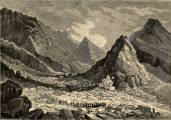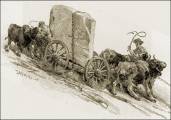


Geology
From the standpoint of engineering geology, the sedimentary rocks throughout the Appalachian Plateaus province can be considered as a unit with the exception of a narrow belt of thick karst limestone along the western border and the limestone and hard sandstone along the eastern border. The rocks forming this unit comprise repetitious sequences of nearly flat-lying siltstone, sandstone, shale, clay, coal, and limestone, each sequence 60-100 feet thick (fig. 22). Because of the great variation in physical and chemical properties of these rocks and their cyclical repetition, they form a separate entity in engineering geology (Philbrick, 1960, p. 49). Their engineering behavior reflects not so much that of an individual member of a sequence, but the integrated behavior of all members.
Figure 22. Sequence of coal (at
base), clay, shale,
limestone and massive sandstone (at top), Harding W. Va.
Most grading, excavation, and other engineering work are in bedrock because soil in the plateau area is thin. Cuts in the rock sequences penetrate successive beds with great differences in slope stability and weathering characteristics, and the overall stability is a balance between weak and competent beds. In addition, open joints, permeability of rock units, and clay seams that act as barriers to movement of water greatly reduce the stability of the rocks and cause landslides and rockfalls.
Typical of rockfalls and landslides are those in the Pittsburgh, Pa., area, which have been costly in lives and money. A short distance northwest of that city, on State Route 93, is a deep cut through sandstone and shale. Formerly the cut was contained between a railroad and a high tree-covered hill and had very steep slopes, steeper than were safe for such rocks. On December 22, 1942, about 150 cubic yards of rocks plunged into the cut and killed 21 persons in a bus. In the previous year, failure of a rock slope moved 100,000 cubic yards into a railroad cut at nearby Brilliant, Pa.; remedial excavation costing $100,000 was required. Inasmuch as 97 such slides occurred in the Pittsburgh area from 1920 to 1954 (Ackenheil, 1954) and 542 occurred in recent years along West Virginia highways (Cavendish, 1953), safe excavations in Appalachia obviously require more than a rule-of-thumb approach. Even in western Pennsylvania, West Virginia, and eastern Ohio, where the plateau is low and rolling slumps are common where clay and shale beds are abundant.
Bearing strength in the rock sequence varies greatly, being low in coal, clay, and shale, and high in sandstone. because of the interbedding of weak rocks, footings for foundations often require special design to carry the weight of structures on competent rock. The fact that the clay and shale also slake rapidly gives rise to additional foundation problems. (Philbrick, 1960, p. 51).
Glacial deposits are a significant factor in engineering geology in the Appalachian Plateaus of northern Pennsylvania and adjacent parts of New York and Ohio (see glacial boundaries on pl. 2). The material varies in composition from clay through coarse gravel. Most of the deposits on uplands are less than 100 feet thick, but deposits in valleys may be 100 feet thick or more. The glacial material has a shallow water table and much of it is saturated. Impervious clay impedes drainage both vertically and laterally and causes cut faces to be unstable and foundations weak.
In Ohio, many large tributary valleys south of the glaciated area contain extensive thick deposits of clay, sand, and gravel washed from the former glaciers. These deposits, which lie on irregular bedrock surfaces, contain large quantities of water and are very unstable. Even shallow cuts with low slopes on their faces slump, and steeper cuts, natural or manmade, commonly result in landslides (Marshall, 1953).
The Interior Low Plateaus province in Appalachia contains flat-lying shale, limestone, and sandstone forming low plateau uplands and isolated knobs and hills. Cherty limestone caps the hills and upland in Tennessee and southern Kentucky. Slumping and sliding are not common except along the eastern edge where relief is higher and interbedded thin shale, limestone, and sandstone are present. Most construction involves bedrock, and excavation requires blasting and heavy machinery.
Caverns and subterranean drainage are problems along much of the eastern part of the Interior Low Plateaus where thick limestone underlies the upland (fig. 16).
The Central Lowland consists mainly of flat-lying shale and limestone covered by extensive areas of wet glacial soils. Cuts in the glacial soils are generally stable only on low slopes, and slumps and slides are common. Terrace deposits along major tributaries of the Ohio River contain thick but unstable gravel deposits that commonly slide or slump when disturbed by construction. Bearing strength of glacial soil is low. Although relief in the Central Lowland is generally less than 150 feet, talus slopes, primarily in limestone areas, are steep and unstable. In the vicinity of Cincinnati, Ohio, several slides caused by construction in talus have resulted in considerable damage to roads and railways. Caves and subterranean drainage, with accompanying engineering problems, are present in the central Lowland in Kentucky. Most construction is in deep soil, and excavation is easy with machinery. Only in the limestone area is extensive blasting required to remove pinnacles of bedrock.
Special Features Influencing Engineering Geology
To a great extent the abnormal rather than normal conditions play a dominant role in engineering geology. Weak soils, landslides, caverns and other unique features, even though of limited extent, generally exert a controlling influence in selecting sites and in construction of various structures. The geologic features involving abnormal conditions fall into two groups, those that are natural and those that are manmade.
In the large area of Appalachia, landscape features that are of importance in engineering geology. Such features as caves and karst topography in limestone are confined to one type of rock. Others, such as faults and landslides, involve many different types of rock.
In the eastern part of the Appalachia, especially in the Blue Ridge and southern part of the Valley and Ridge province, the rocks are cut by many faults (pl. 2). Most of the faults are small, but many prominent large low-angle thrust faults persist for great distances, some being more than 100 miles long. The fault planes range from nearly horizontal to nearly vertical; angles 60°-80° with the horizontal are common. In the Appalachian Plateaus most faults are vertical. These faults are inactive at present, but fracture and gouge zones along them, which contain weak and deeply weathered rock, cause many problems in foundations and tunnels.
Quartzite and hard sandstone that have been involved in faulting are closely fractured and in some places pulverized to loose sand. Shale is highly fractured and sheared into small plates. Extreme shearing, causing zones of highly altered and pulverized rock material, occurs along large faults in shale. These zones, as much as 10 feet thick, generally are weak and cause failures in cut slopes and tunnel excavations. In some limestone and dolomite the shattered rock adjacent to faults has been recemented to form a rock equal in strength to solid limestone.
Local obscure faults cause more engineering problems in Appalachia than the large obvious ones because their existence becomes known only when construction works find them, too late for adequate advance planning to counter their effects.
About 10,400 square miles of limestone and dolomite terrain within Appalachia has solution features developed to a degree that they seriously affect engineering. The landscape, known as karst (fig. 16), consists of sinkholes, open shafts, and blind valleys terminating abruptly at swallow points of streams, and is commonly underlain by caves (fig 10). Karst features are not developed to the same degree on all limestone and dolomite. Most areas show little or no large-scale surface features associated with solution; other areas are dominated by solution features.
Caverns extend mainly from a few feet to about 400 feet below the surface and are a fraction of a foot to as much as 300 feet wide and high. Distinct cavern passages may be less than 100 feet long, yet many caves are formed of interconnected passages measured in miles, and some have passages at several distinct levels. Throughout a cave system, and extending great distances beyond, are small solution cavities and channelways. Foundations over large cavern openings are subject to settling and possible collapse, and under particular conditions, where large heavy structures are to be placed over caverns, foundation treatment is necessary. The location and delineation of the caverns may require extensive drilling, tunneling, and soil stripping. To prevent leakage, solution openings in foundations and abutments of dams in limestone and dolomite areas generally require grouting or other cement filling.
(Please note that the rest of the section on Karst, and the following sections are not reproduced here: Bogs and Wet Soils, Gully Erosion, Debris Slides, Earthquake Effects, Climatic Effects, Manmade Features (Strip Mining, Subsidence), and Special Construction Aspects (Dams, Tunnels and Other Underground Openings.)
Either under present or accelerated rates of development, substantial amounts of earth and rock will be moved in a wide variety of engineering and construction projects in Appalachia. The decisions needed in site selection, the actual methods employed in excavation and construction, and the avoidance of unanticipated movements of rocks and soil during and after construction, can all gain in efficiency and in reduced costs by application of engineering geological studies before such projects begin. Although some types of heavy construction, including highways and dams, are preceded by engineering geological studies in most Appalachian States, the foregoing pages indicate that broader application is possible and is needed.
In addition to specific studies for given engineering projects, it is necessary to expand basic geologic mapping at medium and large scales in the Appalachian Region, with particular emphasis on providing the quantitative lithologic and structural data needed by engineers. Emphasis should also be placed on subsurface investigations by borings and geophysical methods. Future geologic mapping in Appalachia should include more detail on distribution, thickness, and nature of soils and weathered rock; such information is of paramount interest to all involved in construction. Geologic studies also should be expanded to cover field observations on slope stability, subsidence, drilling rates, and other specific data applicable to engineering and to cover laboratory investigations of specific physical characteristics of rocks.
Urban areas, particularly the larger and more actively expanding cities, and rural areas where special or large-scale construction is planned both merit large-scale engineering geology mapping. The resulting maps and reports will serve for long-range planning and in early economies in all types of construction.
Most mapping should be done by conventional methods by geologists and specialists in the engineering applications of geology. However, new instruments that can be used to delineate subsurface contacts between rock and soil have been developed for use in airborne surveying. Included are the microwave radiometer, induced pulse transient systems, and the Ryan scattometer. These instruments may find wide use in one of the most costly and difficult engineering problems in Appalachia, the determination of the subsoil profile of limestone which is so important in foundation work and highway construction.
Commercial use of material within this site is strictly prohibited. It is not to be captured, reworked, and placed inside another web site ©. All rights reserved. Peggy B. and George (Pat) Perazzo.
